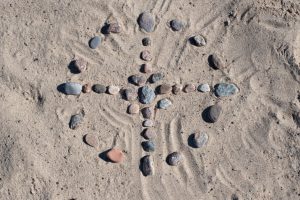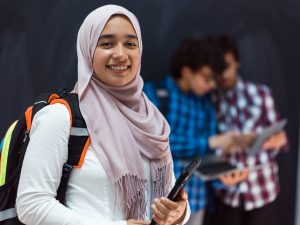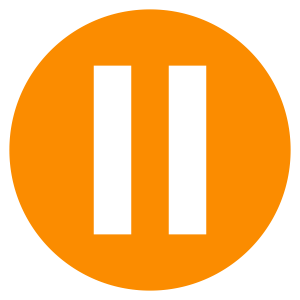1.1 Conestoga and Ontario Colleges
Learning Outcomes
Identify what a college is and its relationship to various bodies
New Faculty Tip
New faculty at Conestoga may wish to create a Conestoga “bookmark” folder in their preferred web browser to save the webpages identified in this Module for easy future access.
For accessibility reasons the hyperlinks in this digital resource do not open new in new tabs. If you wish to navigate between this resource and other web pages, right click links and select “open in new tab.”
The College System on Traditional Lands

Ontario is covered by 46 treaties and other agreements, such as land purchases by the Crown signed between 1781 and 1930. Treaties are legislation that sets out the rights, responsibilities and relationships of Indigenous Peoples in Canada and the federal and provincial governments (Ontario Federation of Labour, 2017).
Figure 1.1.1 indicates the size of the land where Indigenous Peoples, such as the Anishinaabe, have lived.
Land Acknowledgement
At Conestoga College, we acknowledge that in Kitchener, Waterloo, Cambridge and Brantford we are located on the Haldimand Tract, land promised to the Haudenosaunee people of Six Nations, which includes six miles on either side of the Grand River. This is the traditional territory of the Anishinaabe (Ah-nish-nah-bay), Haudenosaunee (Ho-deh-no-show-nee), and Neutral peoples.

Recognizing the land is an expression of gratitude and appreciation to those whose territory we reside on and a way of honouring the Indigenous Peoples who have lived and worked on the land for thousands of years.
Conestoga is committed to building truth and reconciliation for Indigenous Peoples into teaching and College work. Our community works towards reconciliation by committing to learning more and offering more learning about Indigenous cultures, and this brief acknowledgement is only one small part of that effort.
Conestoga and the Public College System

An Ontario college education is unique because it is designed to be hands-on and engaging!
Colleges and polytechnics provide active and career-oriented education to ensure that graduates have the knowledge, skills and attitudes required by program outcomes.
Currently, the Ontario public college system consists of 24 colleges, of which 7 are polytechnics. Conestoga is unique in the college system because it is one of the seven polytechnics in the province!
Conestoga College is a public entity answerable to standards and policies set by the Ministry of Colleges and Universities (The Ministry). The Ministry, and sometimes other external certification bodies, provide key standards and guidelines to colleges so they may deliver current, high-quality education to students.

However, governance is a shared responsibility! While the Ministry is responsible for the administration of policies, laws, and funding related to all 24 of Ontario’s colleges, each college is governed by its own Board of Governors.
All credentials offered by the College must be evaluated at the correct level according to the Ontario Qualifications Framework (The Framework) available on the public web. The Framework provides targeted outcomes for certificates, diplomas, degrees, apprenticeship credentials and more.
You can confirm information about provincially approved college credentials and program standards on a public web portal maintained by the Ministry.
5-Minute Web Search Activity
Do a web search now! Find the
- Program Standards for the course you teach
- Ontario Qualifications Framework for the course you teach
Industry- and Community-Focused Education

Conestoga College provides over 270 full-time programs and learning experiences that are tied to industry requirements and needs. Some industries require specific credentials prior to employment in the field.
In order to qualify for work after graduation, some programs also require students to pass an exam and register with an external governing body.
Here are some examples of programs that require specific exams and registration:
- Certified Red Seal Trades
- Nursing
- Engineering
- Health Information Management

The College ensures that the program curricula have gone through a careful vetting process to prepare students for these specialized requirements.
As well, Conestoga brings education to diverse communities and special populations. Here are some funded programs that support equitable access to education and community needs:
- Women in Skilled Trades (WIST)
- Community Integration Through Co-operative Education (CICE)
- Academic Upgrading
- Language Instruction for Newcomers to Canada (LINC)
Conestoga’s Diverse Students
Conestoga College provides education for an increasingly diverse student population, so our classrooms are supportive, respectful, and inclusive.
Domestic Students
Domestic students may be upskilling in their current careers or seeking an alternate career path while they work. Direct-entry students come from high school with little or no-full time work experience. Newcomers to Canada are also considered domestic students.
Indigenous Students
Conestoga’s Indigenous students include those who are First Nations (status and non-status), Métis and Inuit. Conestoga is in continued collaboration to support and empower the success, prosperity, and well-being of the First Nations, Inuit and Métis students and communities it serves.
International Students

Conestoga students are also international students! Many international students have diplomas or degrees from their home countries and apply for post-graduate programs in Canada. Conestoga supports international students in Ontario and supports their intercultural journey!
Conestoga values the student experience. The College participates in the province-wide Ontario College Student Experience Survey for all students in full-time post-secondary programs. Facilitators join courses selected by Chairs/Chair Designates to conduct the survey.
Conestoga also has a robust student feedback process, which you will learn more about in Module 3.3.
5-Minute Web Search Activity
Do a web search now! Did you know that Conestoga delivers more than 270 career-focused programs in various disciplines and offers more than 20 degrees?
- Go to Conestoga’s programs and courses page to find out more about the program for the course you teach. Is it accredited? Is it a funded program for special populations?
- Go to the Conestoga International web page. What most attracts international students to Conestoga?
 Section 1.1 Review
Section 1.1 Review
Please pause and answer these eight practice questions to review and check your learning.
